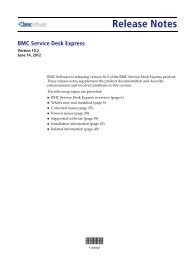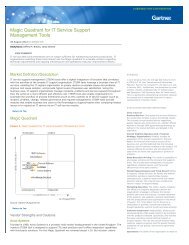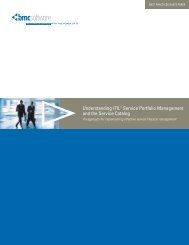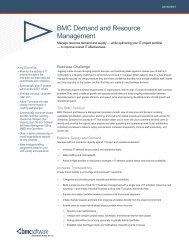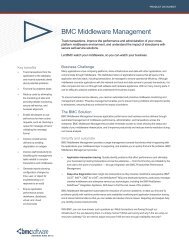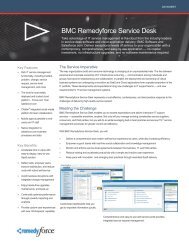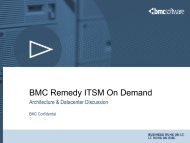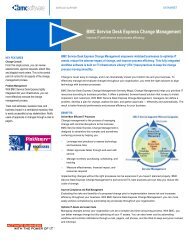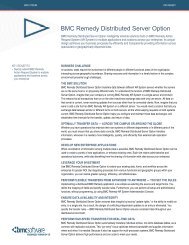Step-by-Step Guide toBuilding a CMDB - RightStar
Step-by-Step Guide toBuilding a CMDB - RightStar
Step-by-Step Guide toBuilding a CMDB - RightStar
You also want an ePaper? Increase the reach of your titles
YUMPU automatically turns print PDFs into web optimized ePapers that Google loves.
The Single Point of Reference<br />
The <strong>CMDB</strong> provides a single point of reference, making it the definitive reference mechanism<br />
for all IT decisions <strong>by</strong> providing business-aware visibility into the dependencies among business<br />
processes, users, applications, and underlying IT infrastructure. This raises the awareness level<br />
for operators of the status of real-time business services, such as e-mail availability, Web site<br />
performance, and so on.<br />
The leading <strong>CMDB</strong> solutions are all built to support a federated <strong>CMDB</strong> approach, meaning that<br />
not all configuration data must reside in a single physical database. Instead, the primary<br />
systems and data repositories remain the authoritative source for information, while the<br />
<strong>CMDB</strong> becomes the reference for where this information lives and how to access it. ITIL V3<br />
now recognizes the importance of this federated approach and recommends that it be a core<br />
part of the structure of a CMS.<br />
With federation, core data is stored in the <strong>CMDB</strong>, which is linked to other, more detailed data<br />
stores. This linkage provides a <strong>CMDB</strong> access to all configuration items (CIs). Hence, the CMS<br />
includes the <strong>CMDB</strong> or multiple <strong>CMDB</strong>s, and through federation, access to all primary data<br />
stores and their respective contents. By adding key functions, such as analytics, dashboards,<br />
and asset management, the CMS extends the value of the <strong>CMDB</strong> across IT.<br />
Influencing Cultural and Organizational Change<br />
An important point to keep in mind as you start down the path of building a <strong>CMDB</strong> is that any<br />
successful implementation of process and tools requires a cultural change. One of the most<br />
important keys to this is selling the benefits of the <strong>CMDB</strong> — not just benefits to the organization,<br />
but benefits to each individual or group impacted <strong>by</strong> the change.<br />
For different people and groups, these benefits will vary. For the service desk, the benefits of<br />
a <strong>CMDB</strong> are greater visibility of all the components and relationships that make up the infrastructure,<br />
which in turn enables faster resolution of incidents, less stress, fewer errors, and so<br />
on. For financial managers, a <strong>CMDB</strong> allows greater accuracy in accounting for all the costs of<br />
IT, and enables calculations of TCO, ROI, etc. For the service level manager, it means visibility<br />
into all the components and relationships that make up an end-to-end service. For the business,<br />
an effective <strong>CMDB</strong> results in greater efficiency and effectiveness of IT, which in turn means<br />
increased agility in meeting the ever-changing business requirements.<br />
Selling benefits is only the beginning, however. As ITIL points out, just changing IT services<br />
isn’t enough to transform an organization. In the end, the organization will evolve in ways that<br />
allow it to use the changed IT services.<br />
Communication both within IT and between IT and the business can improve dramatically<br />
with the implementation of a <strong>CMDB</strong>. In fact, the <strong>CMDB</strong> should become an integration platform<br />
that ties together multiple processes and tools. The organization should put a comprehensive<br />
communication plan into place to assist in managing the cultural changes.<br />
V



